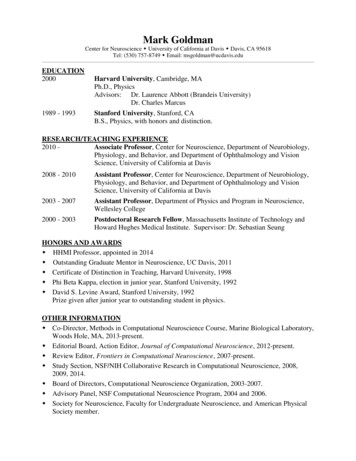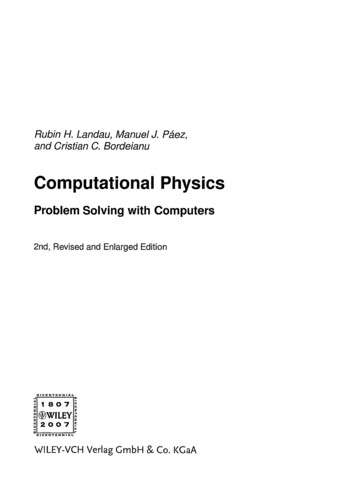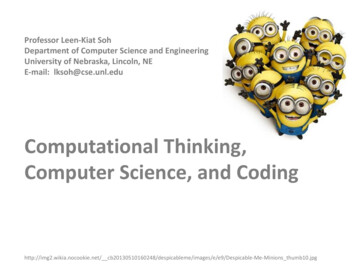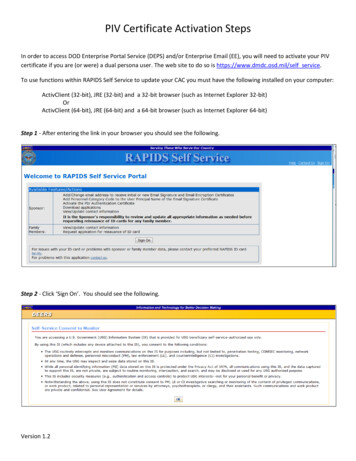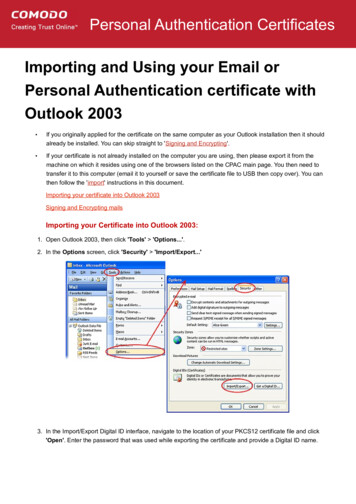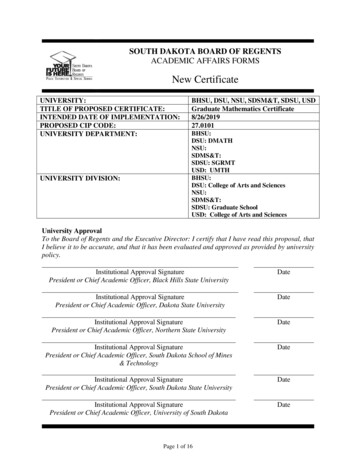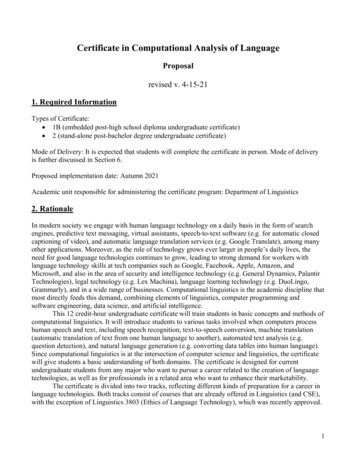
Transcription
Certificate in Computational Analysis of LanguageProposalrevised v. 4-15-211. Required InformationTypes of Certificate: 1B (embedded post-high school diploma undergraduate certificate) 2 (stand-alone post-bachelor degree undergraduate certificate)Mode of Delivery: It is expected that students will complete the certificate in person. Mode of deliveryis further discussed in Section 6.Proposed implementation date: Autumn 2021Academic unit responsible for administering the certificate program: Department of Linguistics2. RationaleIn modern society we engage with human language technology on a daily basis in the form of searchengines, predictive text messaging, virtual assistants, speech-to-text software (e.g. for automatic closedcaptioning of video), and automatic language translation services (e.g. Google Translate), among manyother applications. Moreover, as the role of technology grows ever larger in people’s daily lives, theneed for good language technologies continues to grow, leading to strong demand for workers withlanguage technology skills at tech companies such as Google, Facebook, Apple, Amazon, andMicrosoft, and also in the area of security and intelligence technology (e.g. General Dynamics, PalantirTechnologies), legal technology (e.g. Lex Machina), language learning technology (e.g. DuoLingo,Grammarly), and in a wide range of businesses. Computational linguistics is the academic discipline thatmost directly feeds this demand, combining elements of linguistics, computer programming andsoftware engineering, data science, and artificial intelligence.This 12 credit-hour undergraduate certificate will train students in basic concepts and methods ofcomputational linguistics. It will introduce students to various tasks involved when computers processhuman speech and text, including speech recognition, text-to-speech conversion, machine translation(automatic translation of text from one human language to another), automated text analysis (e.g.question detection), and natural language generation (e.g. converting data tables into human language).Since computational linguistics is at the intersection of computer science and linguistics, the certificatewill give students a basic understanding of both domains. The certificate is designed for currentundergraduate students from any major who want to pursue a career related to the creation of languagetechnologies, as well as for professionals in a related area who want to enhance their marketability.The certificate is divided into two tracks, reflecting different kinds of preparation for a career inlanguage technologies. Both tracks consist of courses that are already offered in Linguistics (and CSE),with the exception of Linguistics 3803 (Ethics of Language Technology), which was recently approved.1
Linguistics expects to be able to meet demand for the certificate with existing teaching resources andcould add sections of many of these courses as needed.Track A introduces students to issues and methods in computational linguistics at a conceptualbut mostly not a technical level and does not require computer programming, although students canchoose to do coursework that involves computer programming. This track will prepare students forindustry work as Language Specialists, Data Specialists, Localization Specialists, Speech DataEvaluators, Voice User Interface Designers, Language Annotators, and for similar entry-level positions.1These jobs generally require a Bachelor’s degree in linguistics, a world language, English, or otherrelevant field. In hiring ads for jobs of this sort, basic knowledge of computational linguistics/naturallanguage processing (NLP) is often an asset and preferred qualification, since workers in these positionswill need to work in teams with language engineers and data scientists. This track is designed to providestudents from any background a basic knowledge of the computational analysis of language data, whichstudents can pair with a BA or BS degree in various fields.Track B introduces students to issues and methods in computational linguistics at both aconceptual and a technical level and requires basic computer programming, which can be developedthrough certificate coursework. This track is designed primarily to prepare students for an MS or PhDprogram in computational linguistics. MS programs, in particular, have sprung up at many universitiesto feed industry demand. However, admission to these programs requires at least a basic background inlinguistics; programming and computer science; and probability, statistics, and formal logic.2 Track B isdesigned primarily for students who are pursuing a degree or otherwise have a background in one ofthese areas but not all three. It will help them bridge the gap between their background and theseprograms’ admissions requirements, while at the same time allowing students to tailor their courseworkto their particular needs. By preparing students for Master’s or higher study in computational linguistics,this track is designed to lead ultimately to industry positions, for example as a Computational Linguist,Language Engineer, NLP Data Scientist, Analytical Linguist (a kind of data scientist), Human LanguageTechnologist, or Research Scientist.3 These jobs generally require an MS or PhD in computationallinguistics, computer science, or statistics.This certificate will complement and add value to a wide variety of majors/degrees: Linguistics,Computer Science & Engineering (CSE), Computer & Information Science (CIS), Data Analytics,Statistics, English, world languages (Russian, Chinese, Arabic, Spanish, German, French, etc.), andmany others not listed here. Computational linguistics touches numerous fields in some way, and soknowledge of computational linguistics adds value to many areas of study. As noted in the program1Sample job ads: Associate Linguist at Lionbridge: https://linguistlist.org/issues/31/31-3342/; Speech Data Evaluator atGoogle: https://linguistlist.org/issues/29/29-763/; Linguist Annotator at Appen: tm campaign google jobs apply&utm source google jobs apply&utm medium organic;Language Specialist at Nuance: https://linguistlist.org/issues/30/30-1273/; Junior Knowledge Engineer at Expert System USA(intelligence and security government contractor): https://linguistlist.org/issues/30/30-3732/; Data Specialist at ; Voice User Interface Designer at Voxify: https://linguistlist.org/issues/22/222096/; Technical Linguist at Artificial Solutions: https://linguistlist.org/issues/26/26-2809/.2See, e.g., the advice from the University of Washington on preparing for their MS in Computational Linguistics paring-for-the-program/3Sample job ads: Language Engineer at Facebook: https://linguistlist.org/issues/25/25-2511/; Language Data Researcher atAmazon: https://linguistlist.org/issues/30/30-2401/; Data Scientist at Bank of England: https://linguistlist.org/issues/27/273258/; Assistant Research Scientist at University of Maryland Applied Research Laboratory for Intelligence and Security:https://linguistlist.org/issues/31.2618/; NLP Scientist at AppTek: https://linguistlist.org/issues/31/31-1008/; ComputationalLinguist at Grammarly: https://linguistlist.org/issues/28/28-1628/; Linguist for Business Application at Gap 0-3841/2
description for the University of Washington’s MS in Computational Linguistics, “. a pre-medundergraduate degree plus a master’s in computational linguistics will position [a student] well for acareer in biomedical informatics. Similarly, legal studies are good background for NLP applications inthe legal domain, and a degree in economics, business or marketing is good training for sentimentanalysis, text analytics and other business-to-business NLP applications.”4Upon completion of the academic Certificate in Computational Analysis of Language, learnerswill be better prepared to:1. Identify the tasks involved in the computational analysis of human language;2. Apply computational methods, statistical methods, and/or formal logic to the analysis oflanguage data;3. Apply core grammatical concepts and principles to the analysis of language data.3. Relationship to Other Programs / BenchmarkingThe two CSE courses (6 credit hours) in Track B of this certificate (CSE 3521, 5525) can also be appliedto the Artificial Intelligence Specialization within the BS in Computer and Information Science(CIS)/Computer Science & Engineering (CSE). However, other courses (totaling 9 hours, including theprerequisite) are unique to the certificate. Within the BA in CIS, students are required to take 12 hoursof Related Field Core courses. This can presumably include courses on linguistics as relevant but is notrequired to. The proposed certificate is thus substantially distinct from the BA and BS degreesadministered by CSE in its central focus on language analysis and linguistics.This certificate also overlaps with the Computational Analytics specialization within the BS inData Analytics. Courses for that specialization (specifically, the Linguistics and Text Analytics Focus)are drawn mostly from the Linguistics curriculum. Most of the courses in this focus can also be appliedtowards the proposed certificate. However, the Linguistics and Text Analytics Focus forms only a smallpart of the Data Analytics major (10 credit hours out of 61 in total), and the proposed certificate offersadditional/unique training specifically in linguistics and the computational analysis of language data,separately from the Data Analytics BS specialization.The proposed certificate does not overlap with any other certificates at OSU that we are awareof. It has not previously been submitted for approval.Comparison to Programs at Other Universities: There are no similar certificates or comparable programsat other universities in Ohio. There are a few undergraduate computational linguistics certificates orconcentrations at other universities in the U.S., including: San Diego State University (4-course undergraduate Basic Computational LinguisticsCertificate): n-computational-linguisticso Required courses: Fundamentals of Linguistics (Ling 501), Computational CorpusLinguistics (Ling 571), Computational Linguistics (Ling 581), and Python Scripting forSocial Science (Ling 572) San Francisco State University (5-course undergraduate Certificate in ComputationalLinguistics): ring-for-the-program/3
o Requires courses: Introduction to the Study of Language (English 420), Syntax (English421), Introduction to Computational Linguistics (English 620), and AppliedComputational Linguistics (English 680). A fifth course is a choice between Phonologyand Morphology (English 424) and Natural Language Technologies (Comp Sci 620)Montclair State University (5-course optional undergraduate concentration in LanguageEngineering within the Linguistics BA): guage-engineering/Rochester Institute of Technology (3-course undergraduate Human Language Technology andComputational Linguistics Immersion): yand-computational-linguistics-immersiono Housed in EnglishSan Jose State University (6-course undergraduate Certificate in Computational emic programs/linguistics/computational linguistics/o Includes a separate programming requirementUniversity of Utah (9-course undergraduate Computational Linguistics ates-and-programs/comp-ling.phpThere are also a number of graduate certificates at other universities, including: Montclair StateUniversity (6 courses), Texas A&M (5 courses), University of Colorado Boulder (5 courses), Universityof Illinois (6 courses), University of North Carolina (3 courses speaker series), University of NorthTexas (4 courses), University of Washington (3 courses).The program at San Diego State University is most similar to Track B in the proposed certificatebut does not seem to include coursework that is as advanced as what is available (optionally) to studentsin our proposed certificate. The SFSU certificate, where the Linguistics Program is housed in theEnglish Department, is closest to our proposed Track A but it places greater emphasis on (noncomputational) linguistic theory courses. Our proposal also allows students more flexibility to tailor thecertificate to their needs and background, compared to both SDSU’s and SFSU’s certificates.Rob Malouf, who runs SDSU’s certificate, reports that this semester in their corpus linguisticscourse, which can be applied to either the Computational Linguistics certificate or a separate TextAnalytics certificate, there are “ 2 big data students, 10 statistics majors, 8 linguistics majors, and 3open university. I assume all of them are probably going to get at least one of the two certificates.” TheComputational Linguistics certificate is the greater draw for linguistics students and the Text Analyticscertificate draws more statistics students. The former also draws a few members of the communitylooking to get jobs in the tech industry.According to Anastasia Smirnova, SFSU’s certificate has “ attracted a variety of majors fromdifferent disciplines and colleges, including Anthropology, Classics, Journalism, Philosophy,Psychology, Creative Writing, Math, Computer Science, and Business. We also have received inquiriesfrom non-matriculated students, but the enrollment for this particular group has been low.” Students whoearn the certificate tend to go on to careers in the local Bay Area tech industry; some find “data science /technical linguist careers in industry. Others find non-technical linguistic jobs in tech companies. Thecomp ling classes are useful because even non-technical positions often have a technical component andrequire good quantitative skills.” At Montclair State, program head Prof. Anna Feldman reports thatabout 20 of 120 Linguistics majors choose the Language Engineering concentration within the major.4
4. Student Enrollment and Justification of Stand-Alone (Type 2) DesignationWe hope that about 15 students per year will earn the certificate in its proposed form. This would beconsistent with demand at institutions with similar certificates, taking into account the overall largernumber of students at OSU and larger number of Linguistics majors/minors.As noted above, colleagues at universities with similar certificates report that enrollment in theircertificates has primarily come from current students and that enrollment from the public has been low.This information has shaped our thinking, leading us to expect that the core constituency for thiscertificate will be current OSU students, who will enroll under the embedded (type 1B) designation.Nonetheless, we believe that there is value in offering the certificate as a post-baccalaureate stand-alone(type 2) program as well. We view the justification for the stand-alone certificate in terms of its value toa narrow OSU-external audience as proposed, but the potential for offering value to a broader audiencein future.First and narrowly, student advising and alumni interactions within Linguistics suggest thatdespite efforts by the department to educate students about possible careers related to Linguistics andhow coursework prepares them for those careers, many students do not begin to think seriously aboutthe job market until their final year at OSU. Anecdotal evidence from these interactions suggests thatpeople who have already graduated often wish that they had taken more computational linguisticscourses, as they come to realize the value to employers of the competencies students gain through thiscoursework. In particular, as noted already, skills in language analysis, when married with enoughtechnical understanding to be able to collaborate productively with engineers, is highly valued in manyindustries involved with natural language processing. Similar anecdotal evidence has emerged frominteractions with students majoring in world languages and we suspect that there may be a similarfeeling among students in other relevant majors. In a narrow frame, we thus see the value of the standalone certificate as being the same as the value of the embedded certificate, because the main audiencefor the stand-alone certificate is expected to be an extension of the core OSU-internal constituency. Forpeople already holding a bachelor’s degree and not enrolled in a degree program at OSU, it offers a wayto add value to their bachelor’s degree even if they discover the need for it after graduation, andregardless of whether that degree is from OSU or another university. The in-person nature of thecertificate will limit enrollment in the stand-alone certificate to people who are local to Columbus andhave schedules flexible enough to attend in-person classes at fixed times. However, Linguistics has anexisting alumni outreach and engagement program, which offers a natural way to do targeted marketing.Linguistics will also advertise the certificate via the departmental website and via other means, toincrease its visibility to people in our local community who do not already have a relationship with thedepartment/OSU.More broadly and more importantly, we are beginning to work with ODEE, who will providemarket analysis to determine whether there is likely to be robust demand among the public for thiscertificate, contra the experience of at least some similar certificate programs elsewhere. We certainlythink that this is a possibility, given the lack of any similar programs at other Ohio institutions and agrowing technology focus in the Columbus/Ohio economy. The reach of other certificates may also belimited by the mode in which they are offered, which we understand to be primarily in person, in whichcase enrollments in those certificates may not accurately reflect demand. The outcome of that research isnot yet known. However, the question will be whether it indicates potential enrollments large enough tojustify modifying delivery of the certificate to make it more convenient to a broader segment of the Ohiopopulation. This would likely involve developing at least Track A of the certificate into a fully onlineprogram. We view Track A as having the most value to the public, since its coursework is most5
accessible to people without a computer science or linguistics background and has the most immediateapplication in the workplace. It is thus most suitable to people already holding a bachelor’s degree whomay be seeking to shift their career focus and/or prepare for 21st century demands of the workplace,without enrolling in graduate school. In this case Linguistics would need to be attentive to guaranteeingthat the certificate program, especially an online version of it, meets the practical needs of this broaderconstituency, something that would require more research and development. We would undertake thisdevelopment in collaboration with ODEE, which would involve going through the change of deliveryapproval process and would likely include collaboration on instructional design. However, if we chooseto follow this path of development, then the stand-alone version may eventually become the dominantpipeline for enrollment.In summary, even if the public audience for the certificate in its current focus is quite small, wethink there is value to bachelor’s holders that parallels the value to current OSU students. Additionally,having an approved stand-alone version will allow the certificate to grow organically to meet the needsof a broader constituency if there proves to be demand. It is of course important that the public-facingcertificate offer the same high-quality and consistent experience that degree-seeking students receivewith the embedded certificate. While expanded marketing of the certificate would require particularattention to the needs of the broader audience being targeted, we believe that development in thisdirection has the potential to offer significant value to the public.5. Curricular RequirementsThis certificate has Linguistics 2000(H) (Introduction to Linguistics) or English 3271 (Structure of theEnglish Language) – as a prerequisite. The certificate is divided into two tracks – a less technical TrackA and a more technical Track B. Twelve credit hours are required in each track, of which six canoverlap a degree program, per university rules for certificates.The certificate is expected to take 2-4 semesters to complete, depending on the particularpathway through the certificate that a student chooses. Since students have some freedom to chooseamong course options, course availability is not expected to be an issue. Courses at the 2000- to 4000level are generally offered every year in both Autumn and Spring semesters. Most of the Linguisticscourses at the 5000-level are offered once per year. Ling 5803 and English/Ling 5804 are offered lessthan once per year but these courses are one of multiple options for fulfilling the certificaterequirements.For most courses no particular facilities or equipment is required in order to complete thecertificate. In the 5000-level classes (relevant mostly to Track B), access to the computing lab in theLinguistics Department (Oxley Hall) may be needed. We anticipate that existing resources will besufficient to meet this need. We do not anticipate any impact on other existing programs.Course RequirementsThe course requirements for the two certificate tracks are listed below. All courses are currently offeredexcept for Ling 3803, which is in development and has been submitted for College review and approval.See Appendix B for sample pathways through the certificate curriculum, Appendix C for the certificatecompletion sheet, and Appendix D for course descriptions and prerequisite courses.6
Track A (less technical)Prerequisite: Ling 2000(H) or English 3271Four courses (3 credit hours each), as follows:1. One course on linguistic analysis (* also offers an introduction to formal logic):a. Ling 2001: Language and Formal Reasoning*b. Ling 4100: Phoneticsc. Ling 4200: Syntaxd. Ling 4300: Phonologye. Ling 4350: Morphologyf. Ling 4400: Linguistic Meaning*2. Introduction to human language technology (core course):a. Ling 3802(H): Language and Computers3. One language and technology elective:a. Ling 3801: Code Making and Code Breakingb. Ling 3803: Ethics of Language Technology4. One course on methods and tools for computational analysis of language:a. Ling 2051(H): Analyzing the Sounds of Languagei. Note: Although at the 2000 level, this course requires students to use R functions forstatistical analysis of language data5b. Ling 5050: Technical Tools for Linguistsc. English/Ling 5804: Analyzing Language in Social MediaNo prior knowledge of computer programming is required for courses in Track A.Track B (more technical)Prerequisite: Ling 2000(H) or English 3271Four courses (3 credit hours each), as follows:1. One course on linguistic analysis or introduction to human language technology:a. Ling 3802(H): Language and Computersb. Ling 3803: Ethics of Language Technologyc. Ling 4100: Phoneticsd. Ling 4200: Syntaxe. Ling 4300: Phonologyf. Ling 4350: Morphologyg. Ling 4400: Linguistic Meaning2. Introduction to computational linguistics (core course):a. Ling 5801: Computational Linguistics 13. One upper-division course on computational linguistics methods and tools:a. Ling 5050: Technical Tools for Linguists*b. Ling 5802: Computational Linguistics 2c. Ling 5803: Computational Semantics5R is a programming language for statistical analysis and data visualization7
d. English/Ling 5804: Analyzing Language in Social Mediae. CSE 3521: Survey of Artificial Intelligence 1f. CSE 5525: Foundations of Speech and Language Processing4. One additional course from either 1. or 3.*For students without a background in computer programming, this course (or another introduction tocomputer programming) is strongly recommended prior to taking Ling 5801.6. Mode of DeliveryIt is expected that students will complete the certificate in person (P). The following certificate courseshave permanently approved distance learning (DL) versions: Ling 2000(H): Introduction to Linguistics (one of two options to fulfill prerequisite in Track Aand Track B) Ling 4100: Phonetics (one of 6-7 options in Track A and Track B) Ling 3801: Code Making and Code Breaking (one of two options in Track A) Ling 2051(H): Analyzing the Sounds of Language (one of three options in Track A)Ling 2000(H) is offered semesterly in both in person (P) and distance learning (DL) versions. The otherthree courses are offered as P on a semesterly basis. However, prior to SP20 they had never been offeredas DL and going forward Linguistics expects DL version to be offered less than annually – perhaps 20%of all offerings.This makes it possible in principle for students to complete Track A of the certificate by takingmore than 50% of courses in the DL modality. However, given that all four of these courses are offeredin the P modality regularly, but three are not expected to be offered frequently in the DL modality, itseems unlikely that students will complete the certificate as DL in practice. Assuming 20% DL offeringfor these courses, we calculate the chance at about 2%. The certificate is thus rarely if ever expected totrigger the threshold for being considering an online certificate. Note that it is impossible to completeTrack A with 100% DL courses (i.e. as a fully online certificate) and it is also impossible to completeTrack B with even 50% DL courses. Students can always complete both Track A and Track B withonly P courses.At the same time, we recognize that it is important to guarantee that students have a consistentand high-quality experience with the certificate, and that extra attention to student experience is neededfor online programs, especially public facing ones. Moreover, DL and hybrid (DH) are growing asmodes of course delivery at OSU. Having become more familiar with online instruction during thepandemic, both students and instructors may have more interest in taking/offering courses in thismodality in future. Linguistics will thus track on an annual basis whether the 50% DL/DH threshold forbeing an online certificate is triggered by enrolled students, with particular attention to students enrolledunder designation 2 (stand-alone certificate). This information will be included as part of theDepartment’s assessment of the certificate (described below). Linguistics will also monitor for anycourse delivery changes to hybrid (DH) or DL that will impact the mode of delivery of the certificate.Should the situation change such that it becomes likely that some students will complete the certificatewith 50% DL or DH courses, or if the data otherwise warrant action, Linguistics will proactively gothrough the change of program delivery approval process.8
7. AssessmentWe have identified three learning outcomes students are expected to attain after completing theCertificate in Computational Analysis of Language. All courses included in the program are mappedonto each of these learning outcomes and are provided below. Course descriptions are included inAppendix D.Outcome 1: Students will identify the tasks involved in the computational analysis ofhuman language. Courses: Ling 3802(H); Ling 5801; Ling 3801; Ling 3803; Ling 5802; Ling 5803; Ling5804; CSE 3521; CSE 5525Outcome 2: Students will apply computational methods, statistical methods, and/or formal logicto the analysis of language data. Courses: Ling 3802(H); Ling 5801; Ling 4100; Ling 2051(H); Ling 5050; Ling 5802;Ling 5803; Ling 5804; CSE 3521; CSE 5525Outcome 3: Students will apply core grammatical concepts and principles to the analysis oflanguage data. Courses: Ling 2001; Ling 4100; Ling 4200; Ling 4300; Ling 4350; Ling 4400EvaluationThe Linguistics Undergraduate Curriculum Committee (LUCC) will conduct an assessmentusing several metrics, using both direct and indirect measures, to evaluate the viability of the certificate,mode of delivery, attainment of learning outcomes, and student satisfaction. First, the LUCC will trackenrollments of students in the certificate program and their completion rates over time, including modeof delivery as described in the previous section. It is important to the department that our efforts beworth the time invested in overseeing the program, while it is important to students that they are able tocomplete the program within a reasonable timeframe. Second, student performance as determined byfinal grades in certificate courses will be used to compare those students completing the certificate tothose who are not. Given that The Department of Linguistics has not offered a certificate up until now,we would like to be aware of potential differences between certificate and non-certificate students.Third, to ensure that each expected learning outcome is met, the LUCC will work with course instructorsto develop a set of questions that align with each of the ELOs. Given that these are program learningoutcomes, and not course outcomes, these questions will be included in an exit survey required ofstudents upon completing the certificate. The Undergraduate Coordinator, also part of the LUCC, willoversee the entire assessment by tracking enrollments, completion rates, and student grades. Thecoordinator will also administer the exit surv
Computational linguistics is the academic discipline that most directly feeds this demand, combining elements of linguistics, computer programming and software engineering, data science, and artificial intelligence. This 12 credit-hour undergraduate certificate will train students in basic concepts and methods of computational linguistics.
